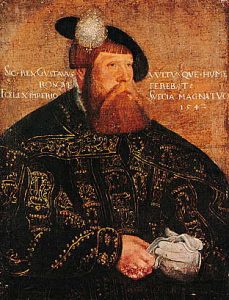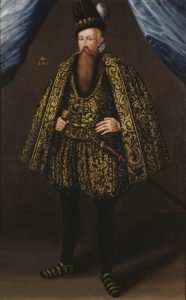
King Gustav Vasa. Jacob Binck. Wikimedia Commons.
Gustav Vasa, the newly elected king of Sweden, faced a serious problem, as his country was nothing short of bankruptcy. The King was acquainted with the new Protestant ideas criticising the Church of having too much worldly power and riches, and given his situation the King decided to lead his country towards Lutheranism. The decisive event was the calling of the Riksdag, the Swedish parliament, to the town of Västerås in 1527. The Riksdag ordered the bishops and Cathedral chapters to give an account of their property to the King, who then took over the lion’s share of the Church’s goods. Important ecclesiastical positions were filled with persons favourable to the Lutheran cause and the King was appointed as the head of the Church instead of the Pope.
After King Gustav I’s death in 1560, his son Erik XIV was crowned king, but he was soon dethroned because of mental instability. His brother John, married to the Polish Princess Catherine Jagiellon, was then crowned in 1568. Importantly, Catherine was a Catholic, and the now King John III had promised to raise their son Sigismund in the Catholic faith.
King John III was interested in the Catholic faith. This might be due to the fact that the country was still in a rather poor economic state, and the Pope might have helped him to get a share of his mother-in-law’s fabulous fortune. Queen Catherine had a considerable role in the negotiations and was the most prominent figure in the Counter-Reformation in Sweden. However, despite all their efforts, relations with the Holy Seat did not improve.

King John III: Johan Baptista van Uther. Swedish National Museum. Wikimedia Commons.
When King John III died in 1592, his Catholic son Sigismund inherited the Swedish crown. Sigismund, however, was already King of Poland-Lithuania, and bound to live there. As Sigismund was not able to respond rapidly to the changed situation in Sweden, his uncle, King John’s brother, Duke Charles took the initiative and summoned a meeting in Uppsala. There the Lutheran faith was confirmed as the religion of the Swedish realm. When Sigismund arrived in Sweden, he had to accept the decisions of the Uppsala meeting before his coronation. This meant that even though he was nominally the head of the Swedish Church, he could not appoint Catholics as archbishops and his powers as a monarch were also reduced in other respects.
Sigismund had to return to Poland-Lithuania, and while away, Duke Charles quickly became the de facto leader of Sweden and soon enough was in open war with King Sigismund. The enmities between Duke Charles and King Sigismund particularly affected Finland, as they caused revolts and a small scale civil war in the country. Nobles in Finland remained faithful to Sigismund until 1599, but Duke Charles eventually seized the entire kingdom and was crowned king. His coronation was the final seal making Sweden and Finland Lutheran countries.
Nobles
The nobles in Finland had a practical attitude towards religion in the midst of the Reformation. Religion was not a matter of indifference to them, but the Reformation did have very practical consequences. For instance, when nunneries were closed, how was one to take care of the non-married women in the family? How did one ensure the family would get back the land donated to the Church during the Catholic period?
Some nobles in Finland might have been sympathetic to the Catholic cause, at least Klaus Eriksson Fleming, one of the highest officials in Sweden, supported the Catholic King Sigismund and endowed some Catholic priests. He even was favourable to the idea of separating Finland from Sweden and incorporating it into Poland-Lithuania. His death in 1597 put an end to these plans.
The Counter-Reformation in Finland
Queen Catherine Jagiellon was the central figure in the Counter-Reformation in Sweden and Finland. She had close contacts with Poland-Lithuania, from where the legate of the Pope co-ordinated the missio Suetica (‘Mission in Sweden’). The plan was to appoint Catholics to key positions in Sweden and to influence King John III, who was already sympathetic to Catholicism. Catherine also supported many Catholic priests and laymen, as well as the convents of Vadstena and Nådendal, and she also helped Jesuits who were sent to Sweden.
Finland was more sympathetic to Catholicism than Sweden, and many Catholic customs remained in usage among the lay people for many decades after the Reformation. For example, rosaries were still used in Finland as late as the 17th century as part of the Marian devotion.
Leave a Reply